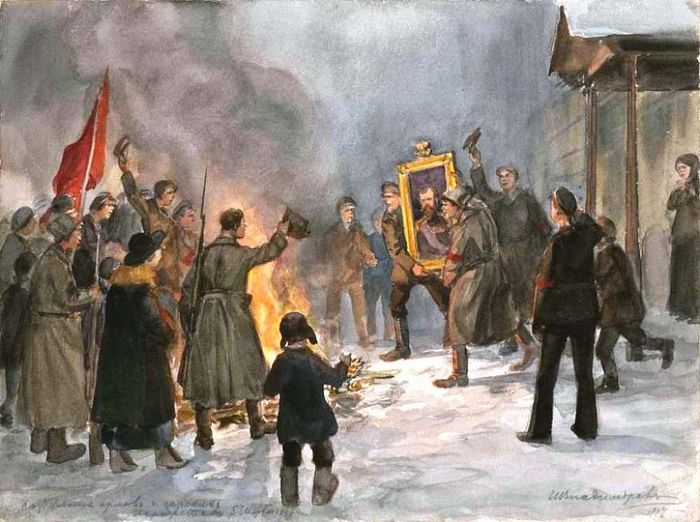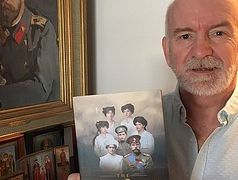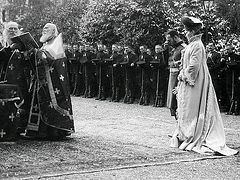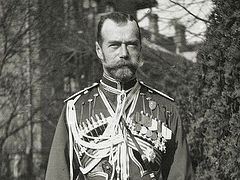 Revolutionaries burning the Tsar’s portrait in 1917. Artist: Ivan Alekseevich Vladimirov (1869-1947)
Revolutionaries burning the Tsar’s portrait in 1917. Artist: Ivan Alekseevich Vladimirov (1869-1947)
Contemporary historians have led us to believe that news of Nicholas II’s death was met with indifference among the Russian people. Rather than conduct their own research on the matter, they choose instead to rehash the popular Bolshevik version of events – this is in itself is not the sign of a good historian.
While the elation exhibited by the revolutionaries is indeed true, it did not reflect the heartfelt sentiments of millions of Orthodox Christians, monarchists and others in the former Russian Empire.
Patriarch Tikhon (1865-1925), openly defended the Imperial family, by condemning the Bolsheviks for committing regicide.
When the tragic news of the murder of the Tsar’s family came, the Patriarch immediately served a memorial service at a meeting of the Council; then served the funeral Liturgy, saying that no matter how judged the policy of the Sovereign, his murder after he abdicated and who did not make the slightest attempt to return to power is an unjustified crime, and those who committed him should be branded as executioners.
On July 17/30 the Patriarch said: “But we, to grief and shame, survived until the time when a clear violation of God’s commandments are not only not recognized as sin, but justified as legitimate. So, a terrible thing happened: the former Tsar Nikolai Alexandrovich was shot … We must, in obedience to the teaching of the Word of God, condemn this action, otherwise the blood of those shot will fall upon us, and not just on those who committed it … Let them call us counter-revolutionaries, let us be imprisoned, let us be shot. We are ready to endure all this in the hope that the words of our Saviour are also referred to us: “Blessed are they who hear the word of God and keep it” (Luke 11:28). “
Eugenie Fraser, born and raised in Russia writes about her years in Petrograd and news of the tsar’s death: “In August, filtered through from Siberia, came the news of the slaughter of the Royal family by the sadistic thugs of the Bolshevik party. Horror and revulsion touched every decent thinking citizen in the town. To execute the Tsar and his wife in this barbaric fashion was bad enough, but to butcher the four young girls and the helpless boy was the work of mindless criminals. In churches people went down on their knees and openly wept as they prayed for the souls of the Tsar and his family.”
“Even in all this turmoil and confusion, and even among those with little sympathy for the abdicated tsar, the brief five-line announcement in July 1918 of the execution of Nicholas II and his family in Ekaterinburg caused a terrible shock,” writes Serge Schmemann. He further notes “Prince Sergei Golitsyn recalled in his diary how people of all levels of society wept and prayed, and how he himself, as a nine year old boy, cried night after night in his pillow.”
Major-General Sir Alfred Knox further noted in his memoirs: “An old soldier . . . breathed into my ear that the Emperor was a good man, and fond of his people, but was surrounded by traitors.”
It is important to recall that it was in the summer of 1918, when Lenin unleashed the first Red Terror. People lived in fear of punishment from the thugs and criminals of the new order, for showing any sympathy for the murdered tsar. Many hid their framed portraits of the tsar, and kept their grief and monarchist sentiments to themselves.




